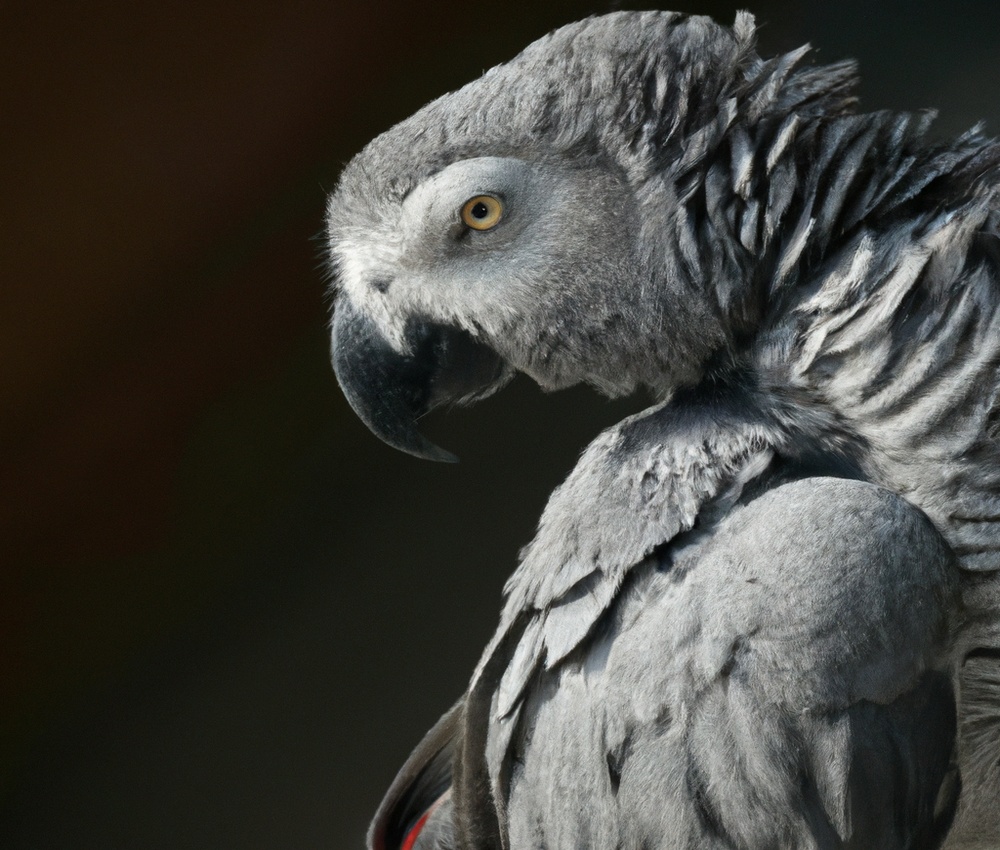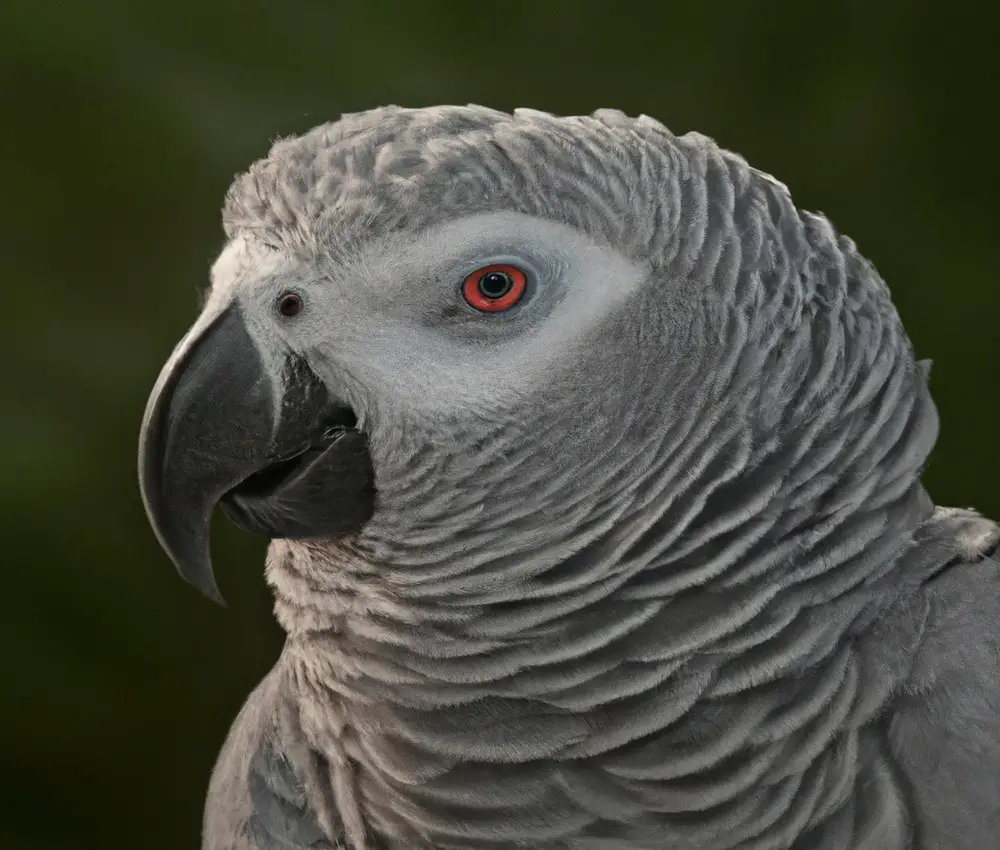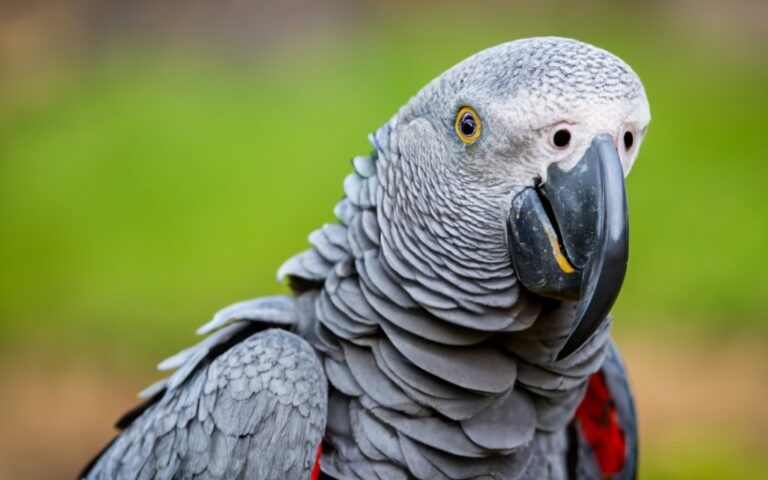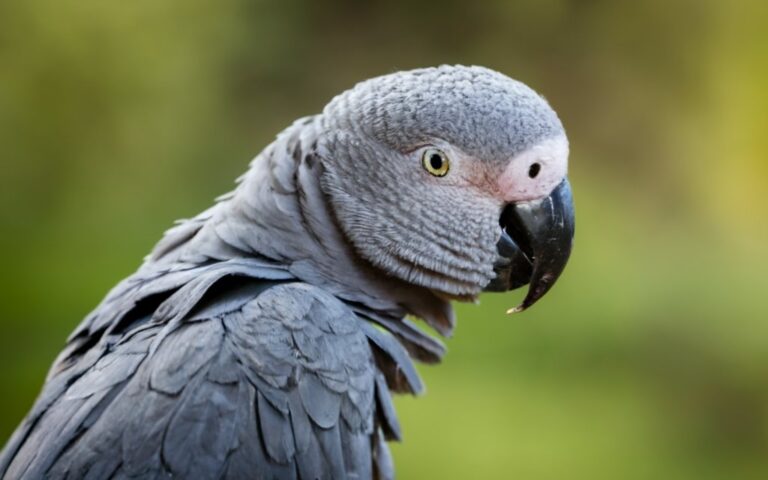How Do African Grey Parrots Forage For Food In The Wild?
Key Takeaways:
- African Grey Parrots forage for food in the wild by using their strong beaks to crack open nuts and seeds.
- They also search for fruits, berries, and other plant materials to supplement their diet.
- African Grey Parrots have a keen sense of hearing and can locate food sources by listening for sounds made by other animals.
- These parrots are intelligent and observant, often learning from others in their flock to find and access food.
Imagine a lush African rainforest, teeming with life and vibrant colors.
In this fascinating ecosystem, one bird stands out with its striking gray plumage and unmistakable intelligence: the African Grey Parrot.
Have you ever wondered how these magnificent creatures find their food in the wild?
Join me on a journey as we explore the foraging behavior of African Grey Parrots.
From their habitat to their physical features, we’ll unravel the secrets behind their survival skills.
Get ready to dive into the world of these captivating birds and discover how they navigate the challenges of finding sustenance in the wild.
| Methods of Foraging | Description |
|---|---|
| Ground foraging | African Grey Parrots search for food on the ground, looking for fallen fruits, seeds, nuts, and insects. |
| Tree foraging | They climb and navigate tree branches, reaching for fruits, nuts, and seeds. |
| Bark foraging | Parrots use their beaks to peel off bark from trees to access hidden insects, larvae, and sap. |
| Seed pod foraging | They crack open seed pods to eat the nutritious seeds inside. |
| Palm fruit foraging | African Grey Parrots have strong beaks that allow them to break open tough palm fruits and eat the pulp. |
Understanding African Grey Parrots
African Grey Parrots are highly intelligent birds known for their ability to mimic human speech and their complex social behaviors. They have unique traits and behaviors that set them apart from other parrot species.
Habitat of African Grey Parrots
African Grey Parrots are native to the dense rainforests of West and Central Africa, including countries such as Ghana, Cameroon, and Ivory Coast. They prefer habitats with tall trees, where they can find food and nesting sites.
These parrots are adaptable and can also be found in savannas and cultivated areas.
African Grey Parrots are highly intelligent and social birds, and their habitat needs to provide opportunities for foraging, flying, and social interaction.

Physical Features of African Grey Parrots
African Grey Parrots have distinctive physical features that set them apart.
They possess a gray body with light gray feathers on their chest and a striking red tail.
Their beak is strong and horn-colored, ideal for cracking open nuts and seeds.
African Grey Parrots also have a large, powerful throat and tongue, enabling them to mimic and imitate sounds and speech with incredible accuracy.
They have strong feet and claws for climbing and grasping, and their wings are long and broad, allowing them to glide gracefully through the trees.
These physical attributes make African Grey Parrots highly adaptable and well-suited for their natural habitat.
Foraging Behavior of African Grey Parrots
African Grey Parrots have unique foraging behavior that involves using their strong beaks to crack open nuts and extract seeds as a primary food source.
Overview of Foraging Behavior
The foraging behavior of African Grey Parrots involves search, extraction, and consumption of food in their natural habitat.
It is a vital aspect of their survival, helping them meet their nutritional needs.
They have various adaptations to find and obtain food, such as beak strength for breaking open nuts and seeds.
Foraging also plays a crucial role in seed dispersion and vegetation regeneration, benefiting the overall ecosystem.
In captivity, providing enrichment and a varied diet can help mimic their natural foraging behavior.

Importance of Foraging in the Wild
Foraging in the wild is essential for African Grey Parrots’ survival.
It allows them to find a diverse and nutritious diet, maintain their physical and mental health, and fulfill their natural instincts.
Foraging also promotes seed dispersion, vegetation regeneration, and plays a vital role in maintaining healthy ecosystems.

Adaptations for Foraging
African Grey Parrots have several adaptations that help them forage for food in the wild.
Their beak is strong for cracking open nuts and seeds.
They also have dexterous feet to manipulate objects.
Their eyesight is excellent, allowing them to spot food from a distance.
Plus, their intelligence enables them to problem solve and find food in various ways.
Food Sources for African Grey Parrots
African Grey Parrots have a diverse diet and rely on various food sources to meet their nutritional needs in the wild.
These food sources include natural foods, fruits and nuts, seeds and grains, vegetables and leafy greens, as well as insects and small animals.
Natural Food Sources
African Grey Parrots primarily feed on a variety of natural food sources in the wild.
Their diet consists of fruits, nuts, seeds, grains, vegetables, leafy greens, insects, and small animals.
These diverse food sources provide them with the necessary nutrients and energy to thrive in their natural habitat.
Fruits and Nuts
Fruits and nuts are important food sources for African Grey Parrots.
They are packed with essential nutrients and provide variety in their diet.
Some fruits they enjoy include apples, berries, and oranges.
Nuts like almonds and pecans are also a favorite.
These foods help keep them healthy and satisfied in the wild.

Seeds and Grains
Seeds and grains are important food sources for African Grey Parrots. In the wild, they forage for various types of seeds and grains, such as millet, sunflower seeds, corn, and wheat.
These provide essential nutrients like carbohydrates, proteins, and fats.
Offering a variety of seeds and grains is crucial for their balanced diet.
Vegetables and Leafy Greens
Vegetables and leafy greens are important components of an African Grey Parrot’s diet. They provide essential vitamins, minerals, and fiber.
Good options include broccoli, kale, spinach, carrots, and bell peppers.
It’s best to offer a variety and fresh options daily to ensure a balanced and nutritious diet for your parrot.

Insects and Small Animals
African Grey Parrots in the wild have a diverse diet that includes insects and small animals.
This can include insects like ants, termites, and caterpillars, as well as small creatures like snails, worms, and even small reptiles or mammals.
These food sources provide essential protein and nutrients for their overall health and well-being.
Insects and small animals are an important part of their foraging behavior, and they use their strong beaks to catch and consume them in the wild.
Techniques Used for Foraging
African Grey Parrots use various techniques for foraging in the wild, including locating food sources, extracting food from hard shells, using tools, and employing social foraging strategies. Let’s explore these techniques in detail.
Locating Food Sources
African Grey Parrots are highly intelligent and resourceful when it comes to locating food sources in the wild. They use their keen eyesight and hearing to spot potential food options such as fruits, nuts, seeds, and insects.
They are also skilled at recognizing the calls of other feeding birds, which can indicate the presence of a food source.
Additionally, they are adept at navigating their habitat and utilizing their beaks and feet to access food in hard-to-reach places, such as breaking open nuts or cracking open seed pods.
Extracting Food from Hard Shells
African Grey Parrots have strong beaks that are well-suited for cracking open hard shells to extract food.
They use their beaks to apply pressure and break open the shells of nuts, seeds, and other hard foods.
Their dexterity and intelligence allow them to manipulate the shells to get to the tasty morsels inside.
Using Tools for Foraging
African Grey Parrots are known for their intelligence and problem-solving abilities. They have been observed using tools for foraging in the wild.
They will often use their beak to crack open hard shells or use twigs to extract insects from crevices.
This behavior showcases their adaptability and resourcefulness in finding food.
Social Foraging Strategies
Social foraging strategies are behavior patterns that African Grey Parrots use when searching for food in groups.
These strategies include:
- Information Sharing: Parrots communicate with each other to exchange information about food sources. They may use vocalizations or body language to indicate the location of a food patch.
- Scanning: Parrots take turns keeping a lookout for predators while others forage. This allows them to stay safe while searching for food.
- Cooperative Foraging: Parrots may work together to obtain hard-to-reach food items. For example, one parrot may crack open a tough seed and share it with the rest of the group.
- Flocking: Parrots often forage in large groups, which increases their chances of finding food and provides protection against predators. They can learn from each other’s foraging behaviors and exploit new food sources.
These social foraging strategies help African Grey Parrots maximize their food intake and increase their chances of survival in the wild.
They demonstrate the complex social behaviors and intelligence of these remarkable birds.
Challenges Faced in the Wild
In the wild, African Grey Parrots face challenges such as competition for food, predators and threats, and climate and seasonal changes.
Competition for Food
Competition for food is a major challenge for African Grey Parrots in the wild. With limited resources, these intelligent birds have to compete with other species for their preferred food sources.
They often encounter other parrots, primates, and even mammals who are also looking for the same fruits, nuts, seeds, and insects.
This competition can lead to limited access to food and the need to employ strategic foraging techniques to gain an advantage.
Predators and Threats
Predators of African Grey Parrots include birds of prey like hawks and eagles, as well as large snakes and mammals such as monkeys and cats. They may also face threats from poachers who capture them for the illegal pet trade.
Habitat destruction and climate change also pose risks to their survival.
Climate and Seasonal Changes
Climate and seasonal changes play a significant role in the foraging behavior of African Grey Parrots.
These parrots are found in tropical regions, where they experience distinct wet and dry seasons.
During the wet season, food sources are abundant as there is an increase in vegetation growth and fruit availability.
However, during the dry season, scarcity of food can be a challenge for these parrots.
They have to adapt their foraging strategies to cope with the changing climate and ensure their survival.
Ecological Impact of Foraging
The foraging behavior of African Grey Parrots has significant ecological impacts, including seed dispersion and vegetation regeneration. They play an important role in ecosystems by contributing to the dispersal of seeds and promoting plant growth.
Seed Dispersion
Seed dispersion is a vital process in maintaining ecological balance.
African Grey Parrots play a significant role in this by consuming fruits and nuts, then dispersing the seeds through their droppings.
This helps in vegetation regeneration and the overall health of ecosystems.
Vegetation Regeneration
Vegetation regeneration is an essential process that African Grey Parrots contribute to in their foraging behavior.
When they eat fruits and seeds, the undigested parts are dispersed in their droppings, helping to distribute seeds across different areas.
This aids in the growth and regeneration of plant life, maintaining the balance of ecosystems.
Role in Ecosystems
African Grey Parrots play a vital role in ecosystems by aiding in seed dispersion and vegetation regeneration.
As they forage for food, they inadvertently help in spreading seeds, promoting plant growth, and maintaining biodiversity.
Their presence also contributes to the balance of predator-prey relationships in their habitats.
Foraging Behavior in Captivity
In captivity, African Grey Parrots exhibit foraging behavior that can be enhanced through enrichment activities and providing a varied diet.
Importance of Enrichment
Enrichment is crucial for African Grey Parrots in captivity. It stimulates their natural instincts and helps prevent boredom.
It provides mental and physical stimulation, reducing stress and preventing behavioral problems.
Enrichment can include toys, puzzles, foraging activities, and social interaction. It is important for their overall well-being and happiness.
Mimicking Wild Behavior
Mimicking wild behavior is an important aspect of caring for African Grey Parrots in captivity.
To promote natural foraging instincts, provide them with enrichment activities such as hiding food, using puzzle toys, or providing foraging stands.
This helps keep them mentally stimulated and engaged, just like they would be in the wild.
Frequently Asked Questions
Can African Grey Parrots find enough food in the wild?
African Grey Parrots are skilled foragers and can find enough food in the wild.
They have a diverse diet, including fruits, nuts, seeds, grains, vegetables, and even small animals.
Their adaptability and intelligence help them navigate their habitat and locate food sources.
So, yes, they are able to find sufficient food in their natural environment.
Do African Grey Parrots eat meat?
Yes, African Grey Parrots do eat meat.
While their diet primarily consists of fruits, nuts, seeds, and vegetation, they also consume insects and small animals in the wild.
This variation in their diet helps provide the necessary nutrients for their overall health and well-being.
How can I encourage foraging behavior in my pet African Grey Parrot?
To encourage foraging behavior in your pet African Grey Parrot, you can try the following:
- Provide foraging toys: Invest in toys that require your parrot to work for their food. Puzzle feeders, foraging wheels, or treat-dispensing toys are great options.
- Scatter food: Instead of placing food in a bowl, scatter it around the cage or in a foraging tray. This mimics the natural behavior of searching for food.
- Hide treats: Hide small treats or pieces of food in different areas of the cage or in foraging toys. This will encourage your parrot to explore and forage.
- Offer food variety: Provide a wide range of food items such as nuts, seeds, fruits, vegetables, and leafy greens. This will stimulate your parrot’s foraging instincts and encourage them to explore different textures and flavors.
- Rotate toys and food: Regularly change the location of toys and food dishes to keep things interesting. This will keep your parrot engaged and challenged.
Remember, it may take some time for your African Grey Parrot to develop foraging behaviors, so be patient and consistent in providing opportunities for them to forage.
Final Verdict
African Grey Parrots have fascinating foraging behaviors that are crucial for their survival in the wild.
They are highly adaptable, using a range of techniques to locate and extract food from various sources.
Their foraging behavior plays a vital role in seed dispersion, vegetation regeneration, and overall ecosystem health.
In captivity, it is important to provide enrichment and a varied diet to mimic their natural foraging behavior.
By understanding and supporting their foraging needs, we can ensure the well-being of these remarkable birds.







